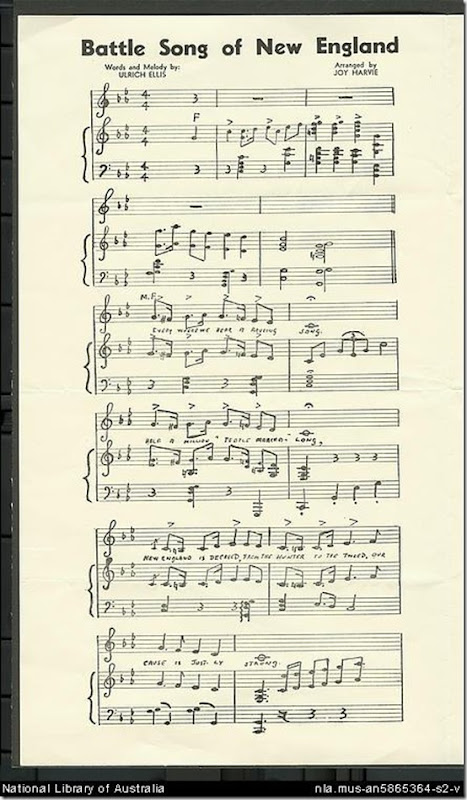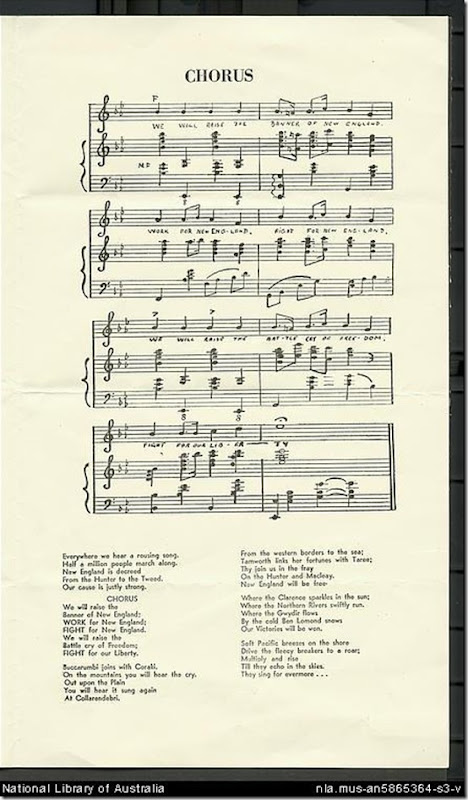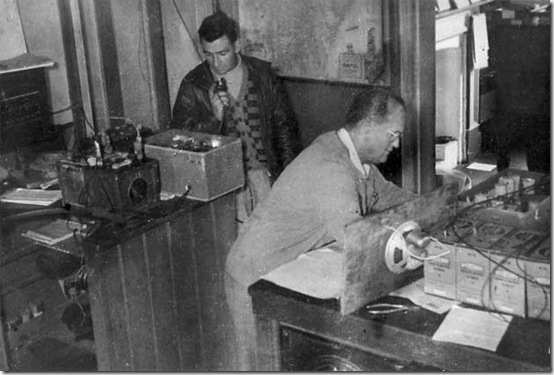Sunday, February 28, 2010
A short break in transmission
Back quite soon!
Saturday, February 27, 2010
Round the New England blogging traps 13 - pastoral
Gaye had a very good post, The Pilliga after rain. The regeneration of our western country after rain is always a miracle. As I sometimes gardener, I also enjoyed My garden.
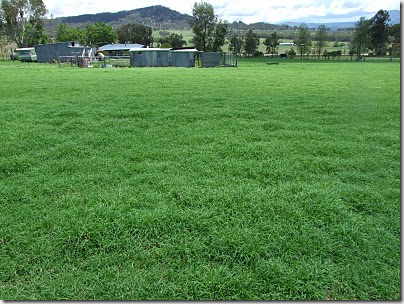 Leanne's World in Big Weekend carries a story of a family visit to Sydney. Back at the start of the year, she also carried a story about the regeneration of country near Tamworth after rain.
Leanne's World in Big Weekend carries a story of a family visit to Sydney. Back at the start of the year, she also carried a story about the regeneration of country near Tamworth after rain.
Look at the photo. That's some grass re-growth!
A Hunter Valley blog, Sharyn Munro's The woman on the mountain has recently had some absolutely great wild life photos. I loved the shots of the wallabies.
A different type of pastoral theme can be found in 18th Century Historical Trekking,1680-1760 (Australia). This blog is a treasure trove of arcane information. One post that struck a chord with me was Primitive Camping, what I think it is and is not. I must write a full post on this one. We are so manicured and controlled today that we have forgotten what it was like to do things simply. At least that's my prejudice!
All for now.
Friday, February 26, 2010
The truth about the Yamba "riots"
Congratulations to Patricia Laurie, The Grafton Daily Examiner and North Coast Voices on this one. Patricia Laurie for putting things in perspective, the Examiner for running the story, North Coast Voices for promoting the truth more widely. 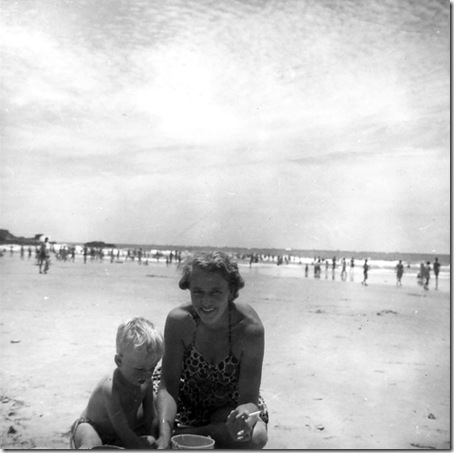
I little while ago I noticed a story in the Sydney about an outbreak of trouble at Yamba. It caught my eye because Yamba has always been a favourite spot for part of my family. Just to add visual interest, this is a shot of Aunt Kay and cousin Jamie at Yamba, 1961.
As is the way with the Sydney media, the story was somewhat sensationalised. Now Patricia has provided a context.
Some years ago, there was a much bigger outbreak of trouble in Armidale's main street. My thought at the time was thank heavens this wasn't spotted by the Sydney press. Restrained local reporting allowed the matter to be worked through outside the type of sensationalised glare that comes from big city reporting.
And, for the benefit of non New England readers, you are actually far safer in Yamba than you would at the better known Bondi Beach in Sydney. It's not that Bondi is unsafe, just that when you have large numbers of people incidents are more likely to happen.
For those that want to know more, you will find the North Coast Voices post here.
New England bushie
Just a family photo today. I feel quite written out.
This shot shows my grandfather, David Drummond, at Forglen near Armidale. Quite the bushy isn't he?
A few things to notice.
The cables going into his top right pocket are his hearing aide.
He became almost totally deaf as a young man. Yet he managed to enter politics when all he could use to overcome deafness was a hearing trumpet.
The dog on the right was Ben. As children, we played with Ben, riding on his back. He was then older and slower, with white streaks. We loved that dog, as did Fa.
Blowed if I can work out just what the shot animal is that he is holding in his hand. Perhaps you can help.
Look at the dead wood in the paddocks, and the tussocky grass. The first was due to clearing, the second the original native pastures. The Northern Tablelands became much more manicured once the native grass was replaced by pasture improvement.
More tomorrow.
Thursday, February 25, 2010
The fragmentation of NSW
This piece is something of a thought piece, triggered by some recent trends. While I do refer to past posts, I am not giving links. I am simply getting ideas down.
Background
When the NSW Government first released its State Plan, I gave it the credit to take it seriously. I first analysed social and economic trends within New England to create a framework for the analysis of the Plan itself. I then looked at the structure and detail of the Plan itself and compared this with my analysis of New England's needs.
While I gave the Government full credit for its efforts, I concluded that the plan was too bitsy, simply an aggregation of existing targets and performance indicators. Even if every target in the plan was achieved, my conclusion was that its practical effect in meeting New England's needs would be negligible. I note that the Plan is presently being updated. This may change my conclusions.
Subsequently, the NSW Government released a series of strategies focused on actions required to meet projected population growth in Sydney and along the NSW coastal strip. Again I analysed them. I concluded that they were mechanistic. I also doubted that that the population targets were achievable, given that the assumptions seemed to imply a continued drift in population from inland NSW that I thought was unlikely to eventuate. If anything, and taking inland NSW as a whole, I thought that pattern of decline was beginning to reverse itself.
Since I wrote, higher levels of overseas migration have changed the equation somewhat.
Population growth in Greater Sydney has always been heavily determined by the combination of overseas migration with emigration from the city. Sydney has always attracted migrants, although its share of the total Australian migrant intake is, I think, showing signs of structural decline. At the same time, Sydney has been loosing population for many decades from out-migration to coastal NSW and to Queensland.
Sydney's overall growth depends on the balance between the two. An increase in the rate of natural population combined with very high overseas migration levels means that rate of population growth in Greater Sydney has increased quite noticeably.
Assuming no change to current high levels of overseas migration, no further change in Sydney's share of the total migrant intake and no increase in the rate of emigration from Sydney, the original population projections look more likely. However, I remain cautious.
If you look at my comments to this point, I am obviously critical of the way the NSW Government approaches its role. However, in saying this I am also conscious of the way in which the progressive fragmentation of NSW, something unique to NSW, has progressively constrained the freedom of the NSW government. Sydney still tries to manage NSW as though it was a meaningful unit, whereas it is in fact a a political and statistical construct made up of increasingly disparate parts.
It is this issue of fragmentation that I want to address in this post.
The Marchland Concept
In looking at the geographic basis of support for the New England New State Movement, the geographer Eric Woolmington suggested that this was greatest where the relative spheres of influence of Sydney and Brisbane overlapped. Using catchment analysis based on population distributions, he defined a theoretical boundary. This placed much of the Northern Rivers and the Northern Tablelands within the Brisbane sphere.
He then used a variety of measures to identify the actual boundary of influence. This placed the boundary much further north, if south of the formal geographic boundary. He concluded that the strongest new state support lay in the geographic area between the theoretical boundary and the formal boundary, with support rising as the formal boundary was a approached.
Similar analysis can be applied to the Riverina, the other area of NSW with sustained support for home rule. In the case of the Riverina, there is a further rough measure that you can use, the sporting boundary between Australian Football and Rugby League.
With time, the spheres of influence of Melbourne and especially Brisbane have expanded, moving north and south respectively. Increasingly, NSW Government policy and service delivery has to take into account Victorian and Queensland needs and positions.
Rise of the ACT
The real kicker in all this is the rise of the ACT, a rise concealed in part by State based statistics.
The following map shows what is now called the Australian Capitol Territory region. This is the area now classified as falling under the influence of metropolitan Canberra where coordinated action is required between the NSW, ACT and local governments. To put numbers on it, around 351,000 people live in Canberra, a further 256,000 people live in NSW in local government areas classified as belonging to the Australian Capital Territory Region, 607,000 people in all. 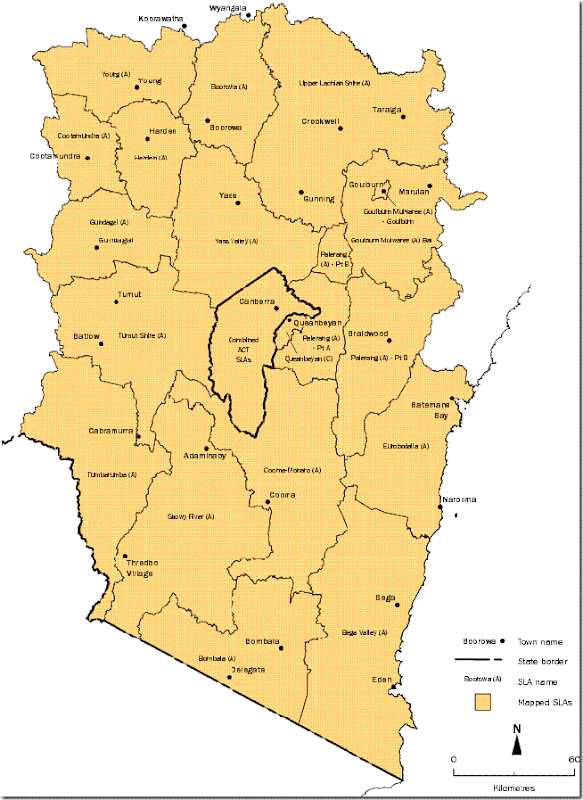
The ABS population projections based on various alternative assumptions suggest that by 2056 the ACT's population will be in the range 374,000 to 683,000.
The lower figure is simply not credible given a current estimated population of 351,000. Canberra will grow as the Commonwealth Government grows, even allowing for a spill-over of population into adjoining regions. If the ACT were to reach 683,000 and if the surrounding area were to grow at the same rate, we are looking at an ACT region population of around 1.2 million sitting just next door to the Sydney conurbation.
Impact of Fragmenation
The overall impact of the processes that I have been talking about can be summarised in this way.
In the North, the Tweed and Richmond River valleys are increasingly affected by and to a degree integrated into the growing SE Queensland conurbation. You can actually see this in some of the language used by the NSW Government. The traditional term Northern Rivers has dropped from use, with the Clarence River Valley increasingly classified as Mid North Coast. For planning purposes, the NSW Government now classifies the Richmond and Tweed Valleys as Far North Coast, while the Clarence Valley is Mid North coast.
In the South East, Canberra has increasingly become the driver. However, there real oddities here:
- Sometimes, the NSW portion of the ACT region - the South East - is called the South East and seems to be classified as coastal in NSW official material, when the coastal strip itself only has 29.5% of the NSW region's population. This actually distorts statistics and approach.
- Then, for NSW planning purposes, the South Coast is defined as Bega and Eurobodalla LGAs (Capital Region) plus Shoalhaven to the North. This is pretty much the traditional definition of the South Coast equivalent to the old definition of the North Coast as the coast north of the Hunter Valley. Also for planning purposes, there is another regional classification called the Sydney-Canberra corridor which includes six of of the 15 or so LGAs in the Australian Capital Region plus an Alpine Strategy focused on the resorts. The missed country LGAs appear to fall outside the land use planning process.
Then to the west of the ACT region we have the area along the Murray increasingly affected by Victoria. This is covered by a Murray Planning Strategy that does explicitly recognise the need for integration on both side of the river.
Even at this level of analysis you can see how confused, confusing and fragmented the whole thing has become.
If we look at the rest of the state land-use planning documents, there are strategies for the illawarra, Metropolitan Sydney, Central Coast and Hunter. This means that planning documents exist for the full coastal strip that generally follow traditional geographical boundaries except, as already noted, in the Northern Rivers area.
All of the state west of the Dividing Range is, with the exception of those areas actually covered by existing plans such as Murray and the Sydney-Canberra corridor simply lumped as Western with a plan to be developed. This makes no geographic sense at all.
This has become quite a long post and has taken a fair bit of time to write. I have a fair bit more material, but this can wait.
Wednesday, February 24, 2010
Belshaw's World - losing country connection
Note to readers: This post appeared as a column in the Armidale Express on Wednesday 17 February 2010. I am repeating the columns here with a lag because the Express columns are not on line. You can see all the columns by clicking here for 2009, here for 2010.
Given that I’m now living in Sydney, I get my Express’s with something of a lag, sometimes I don’t get them at all. It seems that someone in the postal system must like the paper because sometimes all I get is the wrapper!
This makes it difficult to respond to letters to the editor.
To John Bergin first.
At the risk of causing acute distress to my editor, if you write a letter to the editor setting out in more detail where people can find out information about the constitutional structures and implications of different Republican options, I promise to run it on my New England blog as a straight information piece. .
To Dr Fidlon who challenged my constitutional interpretation in Crisis in the Westminster System.
Now I may be wrong, but I think that you are confusing adjourn and prorogue. However, I need to check my own facts.
Turning to other things.
Each year at the start of the new school term I start getting hits from students on the various blog posts I have written on the poetry of Judith Wright. One of my posts drew a very strong response from an anonymous student. I quote:
“Judith Wright, writes about nothing, she created pictures not poems, and as a painter she seems to be rather shitty. I was googling for a school project, i ovbiously have my own opinions on her but this is just a load of bullshit, you think u can relate with her? she creates PICTURES of LANDSCAPE. you relate with a landscape? your a rock? or a fucking tree? or a wave, congrats.”
I limited my response to “City boy are we anon?”. However, it got me thinking further on a topic I have written on before.
I have a very strong sense of country and country side. It may not be quite the same as the Aboriginal sense of country because it lacks the mystic connection with place and object, but it is still very strong.
Growing up, I knew the precise point just to the west of Armidale at which the vegetation switched from Tablelands to Western Slopes.
Driving home to Armidale from the south over the years, suddenly, the cleared tablelands of Kentucky emerged at a particular hill. I was home in my immediate country.
In posts like the colours of New England - http://newenglandaustralia.blogspot.com/2009/09/colours-of-new-england.html - I have tried to capture and explain this sense of country.
When I look at anon’s comment, he (I assume that it’s a he) has captured the fact that Judith Wright’s poetry does indeed provide pictures of a landscape. However, given my sense of country, I then really struggle with his suggestion that one cannot relate to a rock or a tree or a wave. He seems quite alien.
In some ways and on some topics I may be a boring old fart. My family and friends quickly recognise and move away hastily when I fall into a particular lecturing mode.
Yet I do worry that, as a country, we are losing our sense of country.
Modern Australia is a very urbanised society in which the majority of people live remote from the countryside. I see this all the time because it affects every aspect of life and thinking.
At personal level, people’s knowledge of their country has shrunk. They lack the context to understand local events elsewhere, let alone key discussions that depend upon country knowledge.
At policy level, people pontificate without taking into account the almost infinite variety in life across the continent. Governments impose generalised national or state based solutions that simply cannot work given local variety.
Most importantly in all this, too many Australians have lost the joy that comes from actually understanding what it is to identify with the rhythms and detail of the country.
Sorry for the lecture on this. I told you that my family and friends move away when I get into this mode!
Postscript:
I have checked my facts on the points raised by Dr Fidlon in response to my column Belshaw's World - crisis in the Westminster system. I was wrong in my understanding of prorogue, although I don't think that it affects the substance of my argument. I have set the facts out as I understand them in a post on my personal blog, Problems with prorogation.
Tuesday, February 23, 2010
Continuing troubles at Bellingen Hospital
Just a very short one today.
I see that the problems faced by Bellingen Hospital have now made the Sydney Morning Herald. Reading this story and all the previous stories over recent months, I do wonder about the North Coast Area Heath Service.
I don't mean anything sinister by this, nor is it a criticism. It's a genuine question.
Looking back, it's an interesting case of a problem that seems to have spiraled out of control. The Area Heath Service has made several statements and has apparently sent representatives to Bellingen, but things just seem to get worse.
I don't believe that North Coast Area Health Service staff are either incompetent or uncaring, yet they really seem to have been blind-sided. In saying this, I accept that I am working from imperfect information.
The North Coast Area Health Service is a big organisation. I do wonder whether in trying to run a big system under financial constraints that effectively force them to rob Peter to pay Paul, the small Bellingen Hospital was simply so far down the pecking order that they couldn't focus until too late. And then they tried to temporise.
Looking at the newspaper reports on obstetric services, for example, the Area Health Service appears to have stated that it did not intend to close them, but were struggling to find trained staff. There were no reports that I found that explain what they were doing to resolve the problem. In the meantime, obstets at Bellingen has been effectively closed.
From the viewpoint of locals, there appears to have been a constant gap between official statements and the way that things are actually working out on the ground. The result is a loss of trust.
In saying all this, I emphasise again that I am working from limited knowledge. While I know a bit about the world in which the North Coast Area Health Service has been forced to work, I simply don't know enough about its internal workings to be sure of the dynamics.
Monday, February 22, 2010
Tamworth GPs close their books
The Tamworth Statistical District - this includes the main urban area and its immediate surrounds - had a population of 42,499 at the 2006 census, so we are not talking about a small centre.
The Northern Daily Leader now reports that existing Tamworth GPs have effectively closed their books, unable to accept new patients. The story takes place at the same time as debate about the future of Bellingen Hospital reaches a new peak (here and here). As an aside, the Save Bellingen Hospital Facebook page has now reached 2,440 fans!
The NDL story includes some very thoughtful comments from Graeme Kershaw, CEO of the North West Slopes Division of General Practice.
I thought that I might take Graeme's comments as an entry point for some comments of my own, focusing on the different elements of the complicated mess we have created for ourselves. These draw from my own experience as CEO of a specialist medical college, as well as later work force analysis.
Graeme refers to the monumentally stupid decision of the Federal Government to cut back on the number of places for doctors in training back in the 1990s. Then Minister for Health Michael Michael Wooldridge concluded that there were too many GPs and that this was leading to over-servicing, increasing Medicare costs. Training places were cut as a result.
While this was a silly decision, Graeme is correct to suggest that it is only part of the problem. He says first:
“Many trainee doctors are going into the specialities like surgery and internal medicine – not surprising really; while they are training in hospitals they are taught by these same specialties that encourage them to follow in their footsteps”
“Even in doctors who are raised and trained in rural areas, up to 50 per cent choose not to become GPs.”
Let's disentangle this one a little.
In general, not always, specialists get more money than GPS and attract higher prestige, so it's understandable that doctors, and especially those with an academic bent, should be interested in specialisation.
The attempt to create a speciality of general practice has not, to my mind, worked very well. This "specialisation" has in fact added to the hoops that those interested in general practice have to jump through, without affecting the relativities between general practice and the more traditional specialities. To this extent, it may have actually reduced the incentive to become a GP.
I can't judge the validity of the comment on rural training without knowing the equivalent figures for metro trainees.
The extension of medical training at non-metro universities is actually quite recent. My feeling is that things such as the new rural medicine course run by the Universities of Newcastle and New England in combination will have a positive impact.
A central problem, one that applies even more to longer specialist training, is the interaction between partner and family formation and the location and length of training.
People acquire partners from those they are in contact with. As time passes, it is more likely that partner relationships will become long term, including marriage and kids. Increasingly, locational decisions have to take partner considerations into account.
It seems clear that metro born kids are less willing to move to regional areas than country kids. The longer the training in metro centres with their heavy preponderance of metro students, the more partnerships form, the less likely subsequent movement.
This actually affects less prestigious areas in the metro centres as well, with surpluses of doctors and other health professionals in some areas, major deficits in others.
Graeme continues:
Doctors from the “baby boomer” generation received their medical education for free.
“Generations X and Y come out of their training with large HECS debts to repay and they won’t feel the same obligation to the give back to the community that ‘boomers’ once did,” Mr Kershaw said.
This one is hard to measure, although I suspect that Graeme is right. People are influenced by a sense of altruism and community obligation. If you have paid for yourself, the obligation is reduced.
Graeme then looks at service cut backs in local hospitals:
A lot of hospitals in small communities no longer provide obstetric services locally, so they won’t attract the type of rural doctor they once would; someone who wants to deliver babies as well as look after the diabetes and the heart problems.
This is part of the Bellingen Hospital case. Take obstetrics away, and you reduce the practice range of local doctors. However, there is a broader issue as well.
The "specialisation' of medicine in combination with changing approaches to medical indemnity has reduced the willingness and probably capacity of GPs to provide certain services. My tonsils were removed by a GP. Today my parents would have taken me to a specialist. That's fine, but doesn't help much if a specialist is not available.
Graeme finishes:
“GPs are treating much more complex problems, often associated with long-term diseases, than they were 10-20 years ago,” Mr Kershaw said.
“They are doing this at a time when hospitals are developing therapies that mean that people are not in hospital as long as they used to be, and they are discharged back into the care of their GP.
“As a result, GPs cannot see as many people per day as they may have been able to 20 years ago and so, with less people seen and less doctors available, waiting times are increasing.
“GPs realise that they have an ongoing obligation to their existing patients and because of this, have to stop taking new patients.”
Again, I suspect that Graeme is right and the that the problem is going to get worse with an aging population. This adds to the complications, especially in inland areas with limited doctors and an aging population.
Saturday, February 20, 2010
ABC and music in country Australia
Paul Barratt had two very interesting posts on the role that the ABC played in bringing music to country Australia: The ABC and music to country Australia and Isaac Stern and the town hall piano.
As it happened, the print edition of The Armidale Express has just carried a story - it's not on-line - of the expenditure by Armidale-Dumaresq Council of a rather large sum of money to have the piano that Paul referred to in the second story restored to proper concert standard.
Today is music is far more available than it was then. The impact of the ABC concerts was indeed quite profound. Unlike Paul, I am not an especially musical person, but I still enjoyed them.
As I read the story, I thought of one of Paul's class mates at The Armidale School, Philip Bailey.
After taking degrees in Agricultural Economics and in Education, Phil became a teacher. From 1974, he taught in Britain for two years before joining the staff of violinist Yehudi Menuhin. Over the next twenty two years, Phil and partner Tim Coupland (Tim was in my year at TAS) serv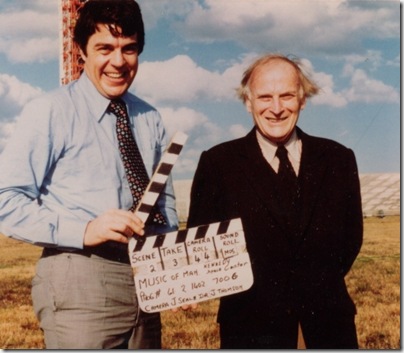 ed the Menuhins in various capacities. Between these commitments, they established an antique restoration business in London, an enterprise generously supported by both Yehudi and wife Diana.
ed the Menuhins in various capacities. Between these commitments, they established an antique restoration business in London, an enterprise generously supported by both Yehudi and wife Diana.
The photo shows Philip Bailey with Yehudi Menuhin at NASA's Apollo lunar mission launch site on Cape Canaveral, Florida, during filming of The Music of Man television series.
Phil has just published the first, Yehudiana, Reliving the Menuhin Odyssey, of a two part series on the violinist's life tracing the Menuhin odyssey from anti-Semitic pogroms of late nineteenth-century Russia to 1947 on the eve of Yehudi's second marriage.
When I look at my the people I knew at school, the different directions we have all gone never ceases to amaze me.
Friday, February 19, 2010
Around New England's Universities February 2010
From time to time I do a round-up of news at New England's various universities. This seems to the right time to do another one with the new academic year just getting underway. It's very interesting, in fact, for the three institutions are very different because of location and history.
At Southern Cross University, the big news has revolved around the University's Gold Coast campus. Orientation kicked off at the new campus on 15 February, with the building officially opened by Deputy PM Julia Gillard on 17 February.
In welcoming Ms Gillard, the Chancellor Mr Dowd, said Southern Cross University had a very clear mission to deliver on the federal government’s education revolution.
“We have more than 16,000 students studying with us, and that number will grow exponentially with this new facility,” Mr Dowd said.
“Only 18 per cent of people at the Gold Coast aged between 25-34 years possess a Bachelor degree or above. This is around half the national average. Fifty-three per cent of all young people in this region are not pursuing any form of education beyond year 12.
“These stark realities stand in contrast to the sun and surf image of the region. We therefore need to add another ‘S’ to this image – that of scholarship."
Other SCU stories included:
- the launch of a carpool, 39 new scholarships under the rising stars program
- orientation week activities for around 3000 newly enrolled students for
 on-campus study and around 900 students who will be studying by distance education
on-campus study and around 900 students who will be studying by distance education - Southern Cross University and ChildFund lead cutting edge research on Vietnamese children. The project involves interviews with 50 children from the rural province of Bac Kan, north of Hanoi. In a culture where children are traditionally ‘seen but not heard’, engaging children in having a say is both important and challenging.
Moving south, the University of Newcastle celebrates the graduation of more than 1,100 students the Central Coast campus. This is an integrated program involving the University, TAFE and the Central Coast Community College. Of the 1,162 students graduating, 931 have completed University of Newcastle programs, 210 have completed TAFE qualifications and a further 21 are graduating from the Central Coast Community College.
On 3 February, the University of signed an agreement with global education provider, Navitas, who are establishing the Newcastle International College on the Callaghan (Newcastle) campus.
Vice-Chancellor, Professor Nicholas Saunders, said the college would be pivotal in the University's growth.
"The University has been working to grow its student numbers. However, in an increasingly competitive market, it is vital that we increase the number of international students coming to Newcastle."
International student numbers at Newcastle have grown over the past five years by almost 30 per cent. Onshore international enrolments now comprise approximately 15 per cent of total enrolments, but this remains below the sector average, which stands at about 20 per cent.
"Working with Navitas as it establishes Newcastle International College will expand the base of international students to the University across a broad range of our programs," Professor Saunders said.
The college will provide programs to international students across a number of disciplines. Successful completion will enable graduates to progress directly to the second year of a university level program.
Other University of Newcastle stories included:
- Recognition for the work of forensic dentist Dr Jane Taylor in the award of an Australian Federal Police Operations Medal for her work identifying victims of the Bali bombing in 2002 and the Boxing Day Tsunami in Thailand in 2004.
- Formalisation of the The Making Educational Goals Sustainable (MEGS) program between the University, Hunter TAFE and NSW DET (Department of Education and Training). This aims to promote education amongst students from targeted equity groups. The new MoU will formalise the partnership and will significantly expand the program with over 650 Year 6 students and their parents visiting the University of Newcastle this year. For many, this will be the first time that they have been in contact with a university.
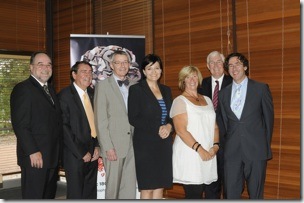
- The launch (photo) of a new data base intended provide schizophrenia researchers across Australia with access to new information to help them treat the condition. This automates data collected by the Schizophrenia Research Institute's University of Newcastle group and collects genetic, clinical and neurological information from up to 4,000 volunteers across Australia.
At the University of New England, new VC Professor Jim Barber has also been welcoming new students at the first day of orientation activities.
More than 1,000 new students attended the official welcome, during which Alicia Zikan, the undergraduate student representative on the UNE Council, also spoke to them about the unique opportunities at UNE for meeting people - both students and staff members - and making friends.
“In your colleges you’re already part of a strong social network,” Ms Zikan said, adding that there were also social networks for students living in the town.
“You’ll have opportunities that students at other universities - sitting in a lecture theatre with 900 other students - can only dream of,” she said.
Professor Barber followed the same theme:
“Our mission at UNE is to change your life,” he told the new students who, together with parents and friends, gathered yesterday on the lawns of “Booloominbah” - the picturesque heart of the University’s campus.
Professor Barber predicted that, as well as acquiring “skills that will make your career” and “a passport to travel the world”, they would make life-long friendships - many even finding their life partner.
“I’m more confident of making these predictions about UNE than I would be about any other university,” he said, explaining that the strong and lasting friendships formed at UNE were something he had been aware of throughout his career.
“I hope you’ll be proud of being UNE alumni,” he concluded. “Welcome, good luck, and let your new life begin!”
The University also reported the results of an unexpected finding in a new research report on science education commissioned by the National Centre of Science, ICT and Mathematics Education for Rural and Regional Australia (SiMERR) at the University that involved around 590 teachers and 3,800 students throughout the country.
Despite the current serious decline in the proportion of senior high-school students taking science subjects, there has been no corresponding decline in students’ enjoyment of science, their appreciation of its importance to society, or their interest in science careers.
If I understand the results correctly, the crux of the problem lies not in lack of interest, but rather in a widening of school choices that has reduced the role of traditional science core subjects.
Other February stories included:
- The opening of a new state of the art $A6.3 million greenhouse complex for plant research. In outlining the structure and function of the greenhouse complex, Professor Gross said it included 25 separate rooms, in each of which temperature and watering could be controlled independently.
- Scientists and research students from five continents participated in the ninth annual Armidale Animal Breeding Summer Course, becoming familiar with the latest genetic technologies for predicting the performance of individual farm animals.
- Industry Placement Scholarships were awarded to 21 school leavers this summer giving them an
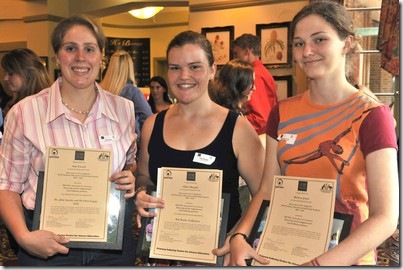 insight into the career opportunities available to science graduates in primary industries. Each student attended a five-day “Science to Industry Camp” based at the University, extending to agriculture-related businesses and laboratories throughout the region. They also completed a five-day “industry placement” working with professional scientists.
insight into the career opportunities available to science graduates in primary industries. Each student attended a five-day “Science to Industry Camp” based at the University, extending to agriculture-related businesses and laboratories throughout the region. They also completed a five-day “industry placement” working with professional scientists. - Andreas Mehl , a distinguished Professor of Ancient History from Germany, is to give a public lecture at the University of New England on 5 March entitled “How the Romans recorded, remembered, thought about, and used their past”. This will be the first lecture for 2010 in UNE’s “Aspects of Antiquity” lecture series, now in its 17th year.
Three universities, three very different stories. Each reflects the different pasts of three very different institutions. In a later post, I will put this in historical context.
Thursday, February 18, 2010
Battle Song of New England
The words and melody of the Battle Song of New England, the anthem of the New England New State Movement, were composed by Ulrich Ellis and arranged by Joy Harvie around 1952.
I first heard it as a sixteen year old at the convention in Armidale that launched Operation Seventh State, the major campaign that finally forced the first plebiscite. I say the first, because I still hope that there will be a second.
The Town hall was darkened, a spot light was shoe on the flag, and the battle song was sung by a very good singer. All very melodramatic, but effective none the less.
The words of the New England Anthem follow:
Everywhere we hear a rousing song
Half a million people march along
New England is decreed
From the Hunter to the Tweed
Our cause is justly strongChorus:
We will raise the
Banner of New England
Work for New England
Fight for New England
We will raise the
Battle cry of freedom
Fight for our LibertyBuccarumbi to Coraki
On the mountains you will hear the cry
Out upon the plain
You will hear it sung again
At CollarenebriFrom the western borders to the sea
Tamworth links her fortunes with Taree
Thy join us in the fray
On the Hunter and Macleay
New England will be freeWhere the Clarence sparkles in the sun
Where the Northern Rivers swiftly run
Where the Gwydir flows
By the cold Ben Lomond snows
Our Victories will be wonSoft Pacific breezes on the shore
Drive the fleecy breakers to a roar
Multiply and rise
Till they echo in the skies
They sing for evermore
The following reproductions from the Australian National Library show the original with music.
Sheet one
Sheet two
Wednesday, February 17, 2010
Raising the New England Flag
This photos shows the 1962 raising of the flag at the new campaign offices in the Minto Building, Rusden Street, Armidale.
As I did with Bill's previous piece in New England Story - new states, archives and the preservation of our past, I will do a full companion piece providing more historical material.
For the moment, its nice just to share the photo!
Belshaw's World - tubing on the Mekong
Note to readers: This post appeared as a column in the Armidale Express on Wednesday 10 February 2010. I am repeating the columns here with a lag because the Express columns are not on line. You can see all the columns by clicking here for 2009, here for 2010.
When I was a kid going out to the Blue Hole, two things were required to make the perfect expedition. One was a rope to swing from, the second a car or truck tube.
The tube was great for just lying in the water, although you always had to watch the valve when the inevitable spills occurred. Do kids still do this, or have tubes just vanished?
I mention this because a whole gang of my daughters’ friends are presently in South East Asia. According to Helen (eldest), this has become something of a right of passage.
This is one of those sprawling modern trips not possible when I was their age. They are all going in different groups, but linked by Facebook, mobiles and travel blogs, they meet at particular points along the way.
Jenny, one of the less inhibited girls in the group and a long standing family friend, has been writing a travel blog. I won't give the link because, while it's a public blog, it’s really being written for the benefit of the group.
I have really enjoyed her trip so far. Jenny writes well and frankly, so its fun even if as a parent I do grit my teeth sometimes!
I was really struck by the way in which places once strange to Australians have become so familiar to the young in the forty or so years since brother David and I went for the first time. The popularity of tubing - I had to look tubing up - in the little Laotian town of Vang Vieng had completely passed me by!
This is the Blue Hole writ large. You get onto a truck tube and just float down the river.
Every so often there are things to see or do, including multiple bars, so you steer the tube ashore. The only constraint in all this appears to be that you must get to the other end of the journey by a certain time or lose your deposit on the tube.
Jen commented in one of her posts "this would not be allowed in Australia!". By this she simply meant that the activity in question would either not be allowed or at least rigidly controlled because it involved some risk.
She is right, of course, and to my mind it points to something of a problem. Australia has become a less relaxed society, with ever growing controls intended to control risk. This doesn’t stop the young taking risks. They simply do it in different ways and in different places.
On Friday, 19 March, I will be presenting a paper in Armidale as part of the University of New England's Classics & History Seminar Series. The topic: “Unrecognised and now almost unknown: explorations through the history of the broader New England”.
Those who read this column will know that I write a fair bit about local and regional history.
I do so because it interests me. However, a few years back when I returned to New England history, I had no idea that my research would become the historical equivalent of an archaeological rescue dig.
To the historians among you, please don’t take this the wrong way.
Local and narrower regional history such as that of the Tablelands is being written. But, to my knowledge, there are few if any looking at the history of the broader North/New England.
When I get a current Australian history book and look at the index, I find that whole slabs of history relevant to our area have gone over the last thirty years.
Of course historical fashions change. But the loss has not been replaced by alternative relevant material. Total visibility has declined.
I think that the desire to know our own past is still strong.
A few weeks back there were calls in the Upper Hunter for the reformation of the New England New State Movement. This led to a request to me for information about the Movement’s history.
Then, a few days ago, I had a request from someone writing a novel set in part in Armidale and Coffs Harbour in the period 1890-1920.
I guess that all this means that you can expect more history in this column!
I don’t want history to dominate. After all, Belshaw’s World is as much about the present as the past.
Yet there is just so much wonderful stuff about our past that I would like to share with you that I don’t think that I will be able to help myself!
Tuesday, February 16, 2010
Local council rate cap reduced to 2.6%
This may be an unpopular thing to say, but the decision by Sydney reduce the cap on increases in local council rates to 2.6% in light with changes in the consumer price index makes very little sense.
Councils are elected bodies that are meant to manage things in the interests of local residents. Putting an artificial cap on spending doesn't make a great deal of sense in the first place, linking it to a measure that has little to do with shifts in councils' real costs makes less sense.
Councils have been complaining for some time that the artificial and arbitrary rule has led to a run down in local infrastructure. There appears to be at least some truth in this.
As early as 1926 those supporting self government in New England were using the case of local government to support their contention that provincial councils would not work as an alternative to new states. They said then, and it has been true since, that Sydney always wanted total control and would interfere whenever it suited them.
The cap is really one of those arbitrary things so beloved by Sydney.
In memoriam - the Great Northern Railway
The following 1988 photo from Gordon Smith's archives shows the railway station at Black Mountain north of Armidale on what was once The Great Northern Railway.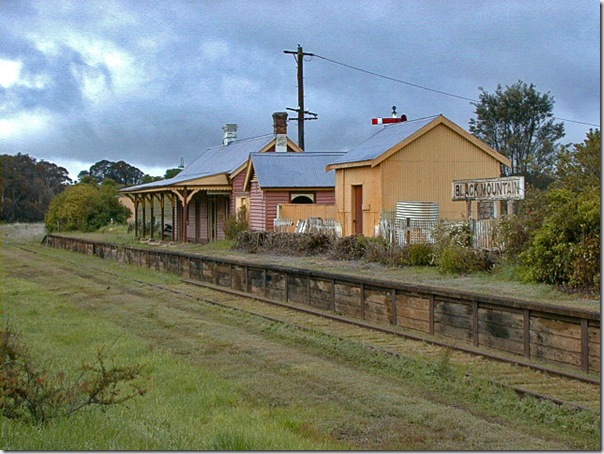
It still distresses me that the Sydney Government should have first stopped trains, then closed and failed to maintain what was once the main railway north. You see, as time passed it became harder and harder to do anything about it.
Call me sentimental if you like, but "hard headed" - I have inserted the italics advisedly - economic decisions that ignore history, sentiment and the the possibilities of future changes are not always sensible.
The Queensland Government has at least kept its part of the line open.
It is no coincidence that Queensland has been far more effective than Sydney in promoting its country rail system. The Sydney lot see rail lines as just transport, Brisbane as transport plus tourism. This is part and parcel of Sydney's failure to develop an effective tourism branding strategy that I have written about before.
Monday, February 15, 2010
Page and Pooaraar's The Great Forgetting
In an earlier post on my personal blog, Train Reading - S H Roberts the Squatting Age in Australia, 1835-1847, I reviewed this pioneering study of the emergence of the Australian wool industry. Then Janine Rizzeti wrote a rather nice companion piece, ‘The Squatting Age in Australia 1835-1847′.
In that piece, Janine included a link to a book by New England poet Geoff Page and Aboriginal print maker Pooaraar (Bevan Hayward), The Great Forgetting (1996) . I had not seen the book before. Janine included the book because it had a poem entitled The Classic Text that dealt with S H Robert's book.
The poems and supporting illustrations look at the interaction between Aborigines and new settlers over time. They can be read at several levels.
At one level, Page and Pooarar's joint work brings out aspects of post European settlement Aboriginal history in a powerful way. I may quibble with aspects from a historical perspective, but it is quite a powerful book.
At a second level, the specific location of some of the poems means that they are likely to be understood by and appeal to many of those from the broader New England. We all like to read work set in our own country. For example, I think that Lynne or for that matter the broader North Coast Voices collective will find them interesting.
Then there is a third level, the linkage between Geoff Page himself, country and New England history.
There are aspects here that I find fascinating and am slowly teasing through.
Geoff is Earle Page's grandson. I am David Drummond's grandson. Judith Wright is PA Wright's daughter. Page, Drummond and Wright were all actively involved in the same New England causes. From somewhat different generations and sometimes different perspectives, their children and grandchildren have all written on Aboriginal issues.
I would not put myself as a writer in the same class as either Geoff or Judith. I am not. I just find the linkage between us all and country and our respective histories fascinating.
One of the huge pleasures I get in writing about New England history lies in the fact that I can sometimes shine light on linkages and relationships that might otherwise get lost.
I do not know whether Geoff Page and Pooaraar's book is still in print. I doubt it. If not, I would love to see it reprinted. In the meantime, please browse the Google Book entry.
Sunday, February 14, 2010
Round the New England blogging traps 12 - peace and protest
It's been a while since I did a blog round-up.
Since starting last Tuesday, the Save Bellingen Facebook page has reached 1,444 fans as of 10.22am Sunday morning. Quite remarkable, really.
I noticed several familiar blogging names appear among the fans: my old friend Sydney blogger Neil Whitfield, Lynne Sander Braithwaite who actually started the Facebook page in the first place because her daughter lives in Bellingen and has just had a baby and Bellingen based blogger Pip Wilson.
Pip has several sites in addition to Wilson's Blogmanac - Wilson's almanac and the Feel Good Manual. He is a member of the Rainbow Region Flikr group.
Pip, who describes his role as web content provision, writing, journalism, editing, came to Bellingen in 1971 attracted by the alternative life style. He has very firm views:
The hospital drama is part of the strategy to make Bello (Repton, Mylestom, etc) suburbs of Coffs, through shire amalgamation, for $$$$$. The battle to save our hospital is SO important. Bello's not Coffs in culture, climate, history & BIOREGION. Coffs was built on a swamp only recently. Less than 100 yrs ago, Coffs people came to Bello to do their shopping at Hammond & Wheatley's. We MUSTN'T let the sharks Californicate our valley. Population explosion/subdivisions is part of the macro strategy - we must wake up to this. Save the hospital, & save Bello.
I can see his point. In Distant memories of a now vanished North Coast - Bellingen, I mentioned that Bellingen's slight remoteness meant that it escaped the sudden development that affected the nearby coast. Gordon Smith's views of Bellingen contains a picture of the store Pip is referring to.
Staying with protest, the North Coast Voices collective has been somewhat stricken with illness and injury leaving Clarencegirl alone at the fort. Hard to get the Premier's attention? Well life's like that in regional New South Wales reports on the continuing efforts to gain political support to improve the Pacific Highway.
Driving on this road north of Kempsey can be quite frightening because of the trucks among other things. Prior to the opening of the road bridges across the Clarence some years ago, interstate truck transport used the inland New England Highway route. Now the ever increasing volume of trucks combines with increasing interstate and local traffic to create a real mess.
I am not sure why people actually use the coastal route. The route that I follow to Brisbane from Sydney is just over one hour longer ( 13hrs vs 12 hrs), but is much easier driving because it avoids the heavy traffic. Mind you, it may not be in my interests to provide details!
Turning from protest to peace, I have just discovered The woman on the mountain. Like Pip, Sharyn Munro is a writer who moved for life style reasons. Now she lives in a solar-powered mudbrick cabin on her mountain wildlife refuge in the Hunter Valley. Here she is, and I quote, "regenerating her property’s vegetation at a pace dictated by ageing knees". This is a gentle blog combining photos and short descriptions.
I discovered Sharyn through Wollombi Valley Online.
Staying in the Hunter, Gaye's Snippets and sentiments continues her exploration of life and nature in the Hunter and Beyond. Like Sharyn and Lynne, Gaye is a grandmother who recorded the birth of her sixth grandchild in January in And Ava makes six. . .. Congratulations.
Mulubinbi Moments, another Hunter bog, does suffer from irregular posting, but is worth checking. I enjoyed the Kakadu posts, while Blogging, internet search engines and privacy contained some thoughts that I actually need to review in a professional sense.
I see that Newcastle Rugby League player Kurt Gidley has taken his blog off-line, so that's another blog down. Last night's initial and very successful Australian All Stars vs Indigenous All Stars saw a thundering tackle from Newcastle and Indigenous second-rower Cory Paterson on Kurt Gidley force his club captain to leave the field.
Craig Wilson's Media Hunter blog continues to provide some remarkably interesting material on media, the internet and advertising.
Finally, Gordon Smith on LookAndSee has been dusting off photos from his archives.
Friday, February 12, 2010
Bellingen Hospital, Facebook and the costs to the community
Yesterday in Bellingen organises to save hospital I reported on the campaign to save services at Bellingen Hospital.
It's been very interesting watching the unofficial Facebook page formed to support the official campaign site. This was created on Tuesday 9 February. As of this morning, it had 812 fans. That's a very rapid growth in such a short time.
The first challenge in a local campaign of this type is to demonstrate local support. The Facebook provides a tangible measure of this.
The second challenge is to spell out the reasons why people want the particular result, in this case saving the hospital's facilities. The official campaign has been doing this, but the Facebook page provides lots of specific examples. It personalises the general arguments.
It also provides information that can be used directly in scoping need. Let me illustrate this by example.
Health planners work with the statistical data they have. This includes census data and health system data including hospital admissions. They are concerned not just with the now, but also the future. Here they use projections that by their nature reflect the past.
There are several difficulties with this approach: one lies in the weaknesses of the statistics themselves; a second is the inability to identify and properly analyse the on-ground effects of decisions.
Looking at the Facebook comments, the examples might be used to draw up a table of adverse effects.
It is clear from the comments that Bellingen Hospital serves a catchment extending from Ebor in the west to Urunga in the east. This broadly but probably not exactly equates to the LGA boundary. In broad terms, the catchment boundaries are set by the travel time to Bellingen compared to the bigger hospitals in Armidale on the west, Coffs in the east.
The first effect of any reduction in services will be an increase in travel time. This will be differential across the catchment and can be mapped.
Dorrigo, for example, is roughly 29k or 26 minutes by car from Bellingen, 124k or 1hr 40 from Armidale, 66k or one hour from Coffs. So any reduction in Bellingen services means increased travel time for Dorrigo people of 1hr 14 in the case of Armidale, 74 minutes in the case of Coffs. The extra cost to patients can be calculated.
Travel times then need to be adjusted for the availability of public transport for those who do not have cars or who must travel by public transport or, alternatively, taxis. Extra time and costs here can also be roughly estimated. Another health cost may be the failure of people to seek treatment when they should, simply because its too difficult.
Travel times also need to be considered in terms of type of illness or accident. Again, the Facebook pages provides personalised examples to be considered. For example, what happens if your child has a sudden asthma attack?
The extra costs of ambulance travel can also be roughly estimated.
This analysis addresses just the direct costs. There are also broader community costs, including access to other Government services. For example, the supply of social housing may be affected because one of the key criteria here is access to services.
No doubt many of these issues have already been picked up by those fighting to save services at Bellingen Hospital. However, the new Facebook page provides extra evidence.
Finally, one of the points that I always try to make in cases like this is that Government policy focuses on the savings to Government on one side, the broad nature of services on the other. The cost shifting to local communities is rarely taken into full account simply because it is harder to measure.
Thursday, February 11, 2010
Bellingen organises to save hospital
While I have never lived in Bellingen, I have known the town all my life and written about it on this blog a number of times.
Bellingen now faces a threat to its hospital services and the locals have organised to try to save it. You will find the Save Bellingen Hospital web site here.
The Bellingen Hospital case is an example of the increasing conflict that has arisen between the needs of centralised service delivery on one side, local needs and indeed history on the other.
To health planners concerned about value for health dollars at a time of budget stress, the idea of rationalising services across broader areas appeals greatly and has done so for a number of years. However, there can be a fundamental conflict between this and local aspirations and needs.
To the health planner, a local hospital is a piece on a chess board to be moved or given up in the interests of the greater game. To the local, the hospital is an integral part of their life. They have worked for it, they were born there, their children were born there, family and friends have died there, they have visited it many times, they know the staff.
You can see this clearly if you look at the newly established Save Bellingen Hospital public Facebook page. Just a few quotes:
- Marguerite: Bellingen Hospital was a very decisive factor in my sea change from Sydney to Bellingen over a decade ago. As a single mother with a young asthmatic child I needed to know that I could access an emergency service, that was close by, no matter what time of day or night. I have indeed used the service many times and wou...ld feel that the community would be robbed of this asset . Although my daughter has since grown up and moved away. I would like to see the hospital survives this senseless closure, ensuring its fantastic care for others with high health risks.
- Briony: I broke my shoulder bone, from a horse riding accident way back when I was about 12. I was treated at Bellingen hospital, they were very good to me!!
- Hannah: I had may major asthma attacks at Bello , they saved my life more than once, and there was never a wait x.
- Laura: My mother and auties were born in Belligen Hospital, all my 7 brothers and
sisters and I were born at Bellingen Hospital, 2 of my 4 children were
born at Bellingen, For 1 i was forced to go to coffs due to bellingens
services being down graded and just 7 months ago I gave birth at home
because it was the only option that suited my family situation. Neither me or my husband drive and many a time we have needed to catch a taxi to make the 4minute trip to the hospital in
the middle of the night when our little pumpkins have been ill. Catching a taxi to coffs or having to wait for a ambulance in the middle of the night is not only unnecessary but could be life
threatening. Please keep the hospital services we have and my wish is
that they will go back to what they were. - Tokana: I know that I've always gone to Bellingen Hospital, even f I needed to be transferred. I will have my children at Bellingen Hospital one day. I love and appreciate the wonderful staff who put in long hours and never complain at what they do -but they do complain about the wages not being enough for the amount of time they put into the hospital and their patients. They also make you feel welcome and important. They're always friendly to patients and each other, and they tend to your needs. SAVE BELLINGEN HOSPITAL!!!!
- Carol: They should go back and read or listen to the The Elders from the Indiginous people of this land as a lot of our relatives use to walk the back road from Bowraville to Bellingen Hostpital to have there babies. My three grand children were born in Bellingen Hostpital and all the Doctors and Staff have always been there for me when I neeed there help SOOOOOO p[LEASE don't close our wonderful hostpital down as the whole Community needs the doors to be kept opened.
- David: As we recently had our hospital closed down in Cowes, I feel for you. Can't these idiots get their priorities right?
If you look at these comments, you can see the way people still love and trust their local hospital at a time when distrust in health services and hospitals has been on the rise.
Over time, the inexorable centralisation of health services has weakened local hospitals. All country people know this. They have seen services withdrawn, forcing them to travel increasing distances for service if indeed they can travel. Not everyone has a car, and public transport is often poor.
This has economic and social effects and actually increases the normal dangers of life. If the Bellinger River floods as it does so often, then access to Coffs may be cut. It becomes harder to attract people to live in specific communities. It becomes harder for older people who may need care to stay in their communities.
One might accept some of these outcomes if country health services were delivering better results. However, the reality appears to be a growing gap in health outcomes between country and metro areas.
Given the fundamental disconnect between the models currently used in health planning and community needs and aspirations, the only weapon available to locals is protest. This is the reason why the Bellingen community is looking to attract as much support as possible for the preservation of the local hospital.
You can help them and also follow the cause by joining the Save Bellingen Hospital Facebook page.
Wednesday, February 10, 2010
Belshaw's World - crisis in the Westminster system
Note to readers: This post appeared as a column in the Armidale Express on Wednesday 3 February 2010. I am repeating the columns here with a lag because the Express columns are not on line. You can see all the columns by clicking here for 2009, here for 2010.
I have avoided getting involved in the topic so beloved by some Express correspondents, the pros and cons of a republic. However, in this column I want to address some constitutional issues that presently worry me, so I need to make my own position clear up front.
I am a supporter of constitutional monarchy and of the Westminster system.
The central problem faced by republicans is that they have failed to address the key question of just what the Australian system of Government might look like under a republic.
The minimalist position put forward at the referendum by Prime Minister Howard simply took the Queen out of the loop, attempting to leave everything else unchanged.
This position was rejected by the combination of those supporting the current system with those opposed to it but who wanted an elected president.
The debate has not advanced since.
Bluntly, any particular republican model put forward to a referendum is likely to be defeated since there is no national consensus on what the relationships should be between Head of State, Parliament and the Executive. Those like me who support the current system will always be able to point to the gap between the current working system and the risks of any alternative.
You might think that this would make me happy and indeed at one level it does. Sadly, however, there are threats to our current constitutional system that both monarchists and republicans need to think about in terms of our future.
Canada is presently facing something of a constitutional crisis following the decision of the Governor-General on the advice of the minority PM to prorogue Parliament until later in 2010.
Prorogue means that that Parliament is actually terminated. Everything on the books at that point including legislation under consideration is relegated to history. When Parliament resumes, it is a new Parliament starting with a blank sheet so far as business is concerned.
The Canadian PM's move is highly unusual and is actually the first technical step that would be required to create a dictatorship. You see, the existing Government continues in power until the new Parliament is formed.
The conventions dictate that that continuing Government should act in caretaker mode. However, there is no legal constraint on what the Government might do so long as formal Parliamentary approval is not required. Proroguing Parliament without an election is a most unusual and potentially very dangerous step.
In some ways the Westminster system rests upon a glorious illusion.
I say illusion because the victors always write the history. In the case of the Westminster system, its history was written by Whig lawyers and historians who wished to present political events in a certain way.
I say glorious because in so doing they articulated a set of constitutional principles and a working constitutional model that was carried round the world.
The first step in the story was the rise of Parliament as a control over Executive Government, in this case the king. Later, during the so-called Glorious Revolution, Parliament established that it had the power to actually appoint the king. The king continued as the head of Executive Government, but Parliament had the power to remove as well as control over the supply of money.
Later still, Executive Government shifted to those members of Parliament controlling a majority in the House of Commons. The concept of Prime Minister and Cabinet had arrived. The monarchy became a figure head, if still with certain reserve powers.
In all this, Parliament retained its centrality as a check on Executive Government.
The form of the Westminster system varies from country to country depending on the date of establishment. However, in all cases history, precedents and conventions are important in determining the way the system actually operates.
Today we live in a period of unparalleled executive power that will override anything considered to be against the national interest, overriding history, precedents and conventions as required.
The divine right of kings has been replaced by the divine right of Executive Government.
This is why many Canadians have reacted with outrage at what they see as a further attack on the centrality of Parliament. Australia could well take a lesson from the Canadian experience.
Tuesday, February 09, 2010
Aeradio and the 1949 Kempsey Floods
In Belshaw's World - Kempsey disaster – six killed, huge damage, I tried to tell the story of the 1949 Kempsey floods. In doing so, I drew from the story of Kempsey Aeradio.
This photo shows the submerged Aeradio facilities at Kempsey aerodrome. You can seethe extent of the flooding pretty clearly.
Following a series of crashes especially along the east coast aviation route, the stations were established to try to improve safety by providing radio contact with pilots.
The next photo shows two of the Aeradio team (Charles Peddell (left) and J Pickles) operating from temporary headquarters in the Kempsey police station. Communications was a major problem during the flood, phone lines and the local radio station were both down, so the Aeradio people's radio skills came in handy. Charles Peddell was later awarded a Certificate of Merit by the NSW Commissioner of Police for his work on restoring communications during the flood.
Sunday, February 07, 2010
Maitland Floods 1955
My Wollombi Valley Twitter Feed drew my attention to the February issue of the Hunter-Central Rivers Catchment Management Authority's newsletter. There I read:
Thursday 25 February 2010 marks the 55th anniversary of the 1955 Maitland flood, which devastated the city of Maitland and claimed 13 lives. The CMA and the State Emergency Service (SES) will be presenting an exhibition of historic photos, which will be on display at Stockland Green Hills from 18-20 February to commemorate the '55 flood and remember the lessons of the past. Following this there will be a special flood tour of the Maitland Court House Precinct guided by local historian and flood survivor Peter Bogan.
These were some big floods. As kids, brother David and went though by train from Armidale as soon as the line was open. There was water everywhere.
I mention all this because Hunter people may not know that Screen Australia has three home movies on-line that show the floods. They are very scratchy, but do give a feel for the sheer power of the water. You will find them here.
Saturday, February 06, 2010
Welcome to Jeremy Smith, problems with writing
Email today from a writer - in this case presently US based - who is writing a novel partly set in New England (Armidale and Coffs Harbour) during the period from about 1890 and 1920. I won't give the plot away except to mention that it involves music.
I have said before what a remarkable number of writers have come from or moved to New England. Of course, since my New England doesn't exist in any formal sense, the presence of those writers and of the differences between writers from different areas is essentially a blank sheet.
Here I would like to welcome a new writer to New England. Jeremy Smith, previously Executive Director at the Australian Society of Authors, is coming to Armidale to teach writing at the University of New England. Jeremy is also a blogger. Welcome, Jeremy, and hat tip to Gordon Smith for the lead.
I think that everybody who writes sometimes suffers from writer's block. I also think that this is far worse for fiction writers. Those bloody characters simply won't do as they are told!
I mention this because Gordon Smith partner's, Bronwyn Parry romance writer extraordinaire, has just written an entertaining post, Knit 1, Write 2, on the writing process.
Some years ago I did actually start to write a novel, a commercial thriller.
At the time I was working in a position that brought me into direct and extensive contact with the Australian and global defence and aerospace industries. I started keeping a writer's log: scenes from the minister's office; plant visits including descriptions of people, machinery and processes; the physical security processes involved in entering a US defence plant; what the offices looked like; details of an official ministerial visit to Indonesia; the words people used; and specific commercial negotiations. The actual details were disguised, but the aim was to create the texture required to support the main story. The background would sound true because it was true.
I suspect that it would have been quite a good novel. However, inconstant person that I am, my ordinary career intervened and I put the project aside. I then lost all my notes in a move.
I am not sure that I will ever return to fiction, although like most writers I still believe that I have a great or, at least, successful novel within me. But it has left me with a better understanding of the agonies and challenges that fiction writer's face.
Friday, February 05, 2010
Dalwood Centre closes, more questions on Tillegra
Back in December new NSW Premier Keneally pledged that the children from rural and remote areas would not be left without the programs the Dalwood Assessment Centre and Palm Avenue boarding school at Seaforth offers until an alternative was in place.
Now according to the Sydney Morning Herald, the Centre has been shut and the 15 specialised staff made redundant. Health and education officials have not been able to find a new location to house the 100 or so children already referred for a four-week stay over the next two terms and cannot agree on an alternative program.
This is one of those small things that are very important to particular parents. I have been following the story in the Armidale Express where a number of locals, including The Armidale School Headmaster Murray Guest, have placed great weight on the importance of the school. This is one of those very silly things that the Sydney Government is prone too, promise then fail to deliver.
Meantime, the controversial Tillegra Dam has come under more questioning with a number of NSW Government agencies expressing reservations about the project.
Update
The NSW Premier has now denied the SMH story on Dalwood; the school just hasn't opened yet. The two stories are so diametrically opposed that it is impossible to make any sensible judgement at this point..
Thursday, February 04, 2010
Inverell District Family History Group reorganises after fire disaster
On 25 January in Fire guts Inverell's historic Byron Arcade I provided a report on this huge fire. I have updated this post a little to include later Inverell Times stories on the aftermath.
One of the things that I focused on in my original story given my interest in history was the loss inflicted by the fire on the Inverell District Family History Group. Fortunately, the Group has taken quick recovery steps. In a comment on the original story, Ann Hodgens wrote:
Jim,
On behalf of the Inverell District Family History Group I'm pleased to report that we have new premises and plan to re-open on Monday 8th February upstairs at 129Otho Street, opposite the Centrelink offices. Whilst we've lost our library,we've managed to salvage most of the material the wonderful fire brigade men were able to obtain from the building after the fire. Our insurance will cover furniture, computers etc. and we've had offers of replacement books. Information regarding several of our current projects was offsite,and the Pioneer Register will continue but may be delayed. Forms are available on our website www.inverellfamilyhistory.org.au.
Our members are determined to continue and we are working hard to rebuild as soon as possible. The support we've received from the family history and history world has been wonderful.
Ann Hodgens
President
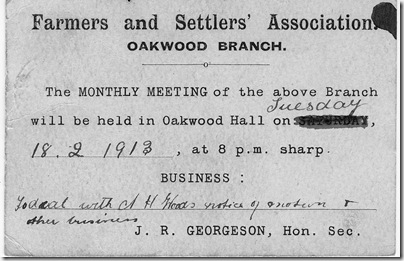 The work that societies like the Group do in preserving the history of families and districts makes a huge contribution to the retention of knowledge about our own past.
The work that societies like the Group do in preserving the history of families and districts makes a huge contribution to the retention of knowledge about our own past.
In my original post, I mentioned that in 1912 my grandfather, David Drummond, came to Inverell to manage Maxwelton, a wheat block created out of the newly subdivided Bannockburn Station. Mum was born while they were living there, so I could claim a personal Inverell connection.
While living at Inverell, my grandfather became an active member of the Oakwood Branch of the Farmers and Settlers Association. This meeting notice is from cousin Jamie's collection. Eight year's later, this active involvement would lead to his entry to the NSW State Parliament.
The back of this photo also from cousin Jamie's collection is inscribed in my grandfather's handwriting "a squatter goes to town"! 
While my grandfather was proud of the fact that at twenty two he was in charge of Maxwelton, managing a wheat block on a share farm basis was hardly a sure course to wealth. Still it did provide sufficient certainty for his marriage in 1913.
The photo itself is not a very good one. Still it's interesting. The young Drummond is quite dressed up, especially for the sometimes hot Inverell climate. You did get dressed up to go to town!
I know far less than I should about various horse drawn vehicles. It remains a gap in my knowledge. However, I think that this is a spider sulky,a light weight vehicle that allowed easy carriage. This was also probably the vehicle in which my grandfather drove his bride to her new home at Maxwelton.
The last photo from cousin Jamie's collection shows Pearl and David Drummond with daughters Edna (mum, left) and Phyllis. The photo would have been taken about 1915 or early 1916 not long before Phyllis's sudden death in July 1916 from flue.
Phyllis was an attractive and much loved child, you can actually see this from the ph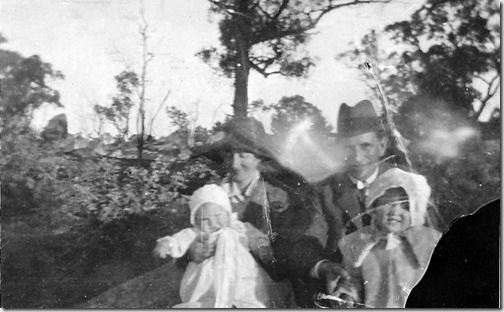 oto, and her death was a tragic blow. We forget today just what a constant presence death was.
oto, and her death was a tragic blow. We forget today just what a constant presence death was.
This short family story may seem to have wandered a little from the Inverell District Family History Group. However, all families have stories that reveal something about life. Their preservation plays a role in the preservation of history.
I would argue that this is especially important today many Australians - and I suspect others in other countries too - are more cut off from their past simply because fashions in history have changed towards the current and general thematic.
Certainly in my work in trying to write a history of New England, as well my writings on my own family, I depend upon the work of local and family history groups.
Congratulations to the Inverell District Family History Group on their courage and strength in responding to disaster.
Wednesday, February 03, 2010
Armidale seminar paper - “Unrecognised and now almost unknown: explorations through the history of the broader New England”.
I am cross-posting this on the New England's History blog as well as here.
On Friday 19 March 2010 I will be presenting a paper in Armidale as part of the University of New England's Classics & History Seminar Series. As the heading says, my topic will be “Unrecognised and now almost unknown: explorations through the history of the broader New England”.
This will be my first opportunity to report in an academic environment on the historical research that I have been doing into the history of New England, so I am quite excited.
While I have an idea of what I want to say, I now have so much material that choice is a bit of an issue.
One thing that I actually have to do is to demonstrate that there is such a thing as the history of the broader New England. This is where the unrecognised and almost unknown comes in. I also want to show why the history of the broader New England is important as a separate thread in Australian history. Last, I want if I can to share my joy in the methodological challenges involved and the pleasure of discovery.
At the moment, my thinking is to prepare two sets of material.
The first is a formal, fully footnoted academic paper. This is important because it allows people to check my research. I can then also use it as a source on things like Wikipedia articles. The second are powerpoints, because this gives me greater flexibility in responding to however many people come.
I mention this now not just because I am quite excited, but also because I know that a number of people are actually interested in our history. If you would like to receive a copy of the paper after delivery, email me ndarala(at)optusnet(dot)com(au) and I will add you to the list.
The importance of a Gin and Tonic
Note to readers: This post appeared as a column in the Armidale Express on Wednesday 27 January 2010. I am repeating the columns here with a lag because the Express columns are not on line. You can see all the columns by clicking here for 2009, here for 2010.
Several years ago flying to Armidale on Qantas, I asked for a gin and tonic only to be told that they no longer served alcohol. I have avoided Qantas as much as possible since.
This may sound an extreme reaction. Surely the man can go for an hour without a drink! However, in my mind it marked the final end of an era, a sad full stop on part of our history.
I suspect that it is hard now for some Armidale people to realise that until the second half of the eighties New England people generally flew on New England owned and headquartered carriers. They were our airlines.
The rise and fall of New England civil aviation deserves a book in its own right. I can only point to a few of the key features.
In Tragedy in New England Skies (AE 6/1/10), I spoke of the formation of Virtue Air Transport and its transformation into New England Airways.
By 1935 New England Airways had flown more than a million miles and had begun to spread its wings.
In October 1935, it was transformed into a new company, Airlines of Australia, with 60% of the capital held by the UK’s British Pacific Trust.
The Trust then sold its shares to the Ivan Holyman controlled Australian National Airways combine. While Airlines of Australia survived for a period after this, its fate was now sealed and it exited stage left.
In 1947 the next major New England airline emerged with the formation of East-West Airlines by Armidale grazier Don Shand.
The early history of EWA was just as remarkable as that of New England Airways as the company scrabbled to survive.
the company scrabbled to survive.
Slowly the company built up its route structure. The photo shows the first landing at Port Macquarie of an EWA DC3.
In 1961 EWA faced its greatest threat when the then Minister for Civil Aviation in the Menzies Government told the company that it must merge with Ansett. Government policy provided for just two airlines and there was no room for a regionally based upstart like East West that was starting to get pretensions above its station.
When East West announced the threat it created a major political storm. The Minister responded by denying that he had said anything of the kind.
Member for New England David Drummond was in a very difficult position. The Menzies Government was on a knife-edge with a one seat majority. However, Drummond also knew that the Minister was, at best, gilding the lily.
White and shaking, Drummond rose to speak to an almost empty House of Representatives. The House and press gallery filled as he spoke, confirming the company’s version of events.
Drummond’s reputation for honesty was such that his statement effectively destroyed the immediate threat.
Don Shand died in 1976. Five years later a consortium led by Bryan Grey (the later founder of Compass) and Duke Minks made a successful bid for EWA.
The new owners took EWA into an aggressive strategy that challenged and finally broke the two airline policy. However, they then sold the airline to Western Australian businessman Rick Stowe who on-sold it to Ansett in 1987.
It may have taken twenty six years, but Ansett had finally gained EWA!
As EWA exited stage left, the door was opened for the third major New England carrier.
As part of the takeover, Ansett had had to agree to East-West giving up some its New England routes. These were taken over by Tamworth based Eastern Airlines.
To fund its expansion, Eastern brought in Australian Airlines as a partner, becoming Eastern Australia Airlines. Then, as had happened before, Australian gained complete control.
All this may seem a long way from the simple question of a gin and tonic.
When I first flew East-West on a regular basis I formed the habit of ordering a gin and tonic on the flight. I carried this onto Eastern. It was just a nice thing to do associated in my mind with home.
When I asked why I could not get a gin and tonic on that Qantas flight, I was told that Qantas Link had just taken over from Eastern Australia and that Qantas Link did not serve alcohol.
An era had ended.

